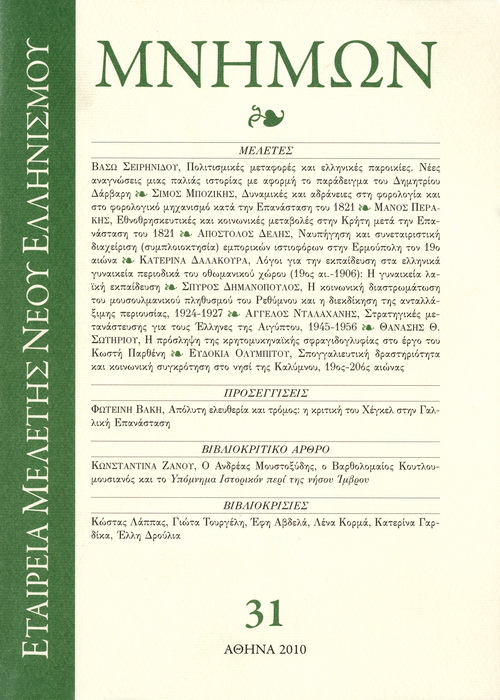Εθνοθρησκευτικές και κοινωνικές μεταβολές στην Κρήτη μετά την Επανάσταση του 1821 <html />
Περίληψη
The revolutionary upheaval, which extended to the island of Crete in 1821 and dominated the Cretan domestic affairs till 1828, did not produce the much desired by the Christians secession of Crete and its incorporation into the Greek State. However, the prolonged revolution of 1821 resulted in radical socio-economic transformations. Perhaps the most indicative of the aforementioned transformations consisted in the remodeling of the population along the following axes: 1) the radical decrease of the population and the eventual numerical superiority of the Christians over the Muslims that upset the pre-1821 numerical balance, and 2) the decline of the Muslim landed aristocracy in the countryside and the subsequent decrease of its political and economic power.The revolution-induced transformations accentuated between 1830 and 1840 when the Sultan ceded the island to the Egypt regent Muhammad Ali. On most of the island, large estates were partitioned, and smaller (mainly Christian) properties became the norm. Moreover, it was during this period that the bases were laid for the economic development of the island, the tanzimat political transformations that followed the return of the island to the Sultan in 1840 and finally the dominance of the Christians over the Muslims. The final result of the long-term procedures set forth by the Revolution of 1821 was the achievement of autonomy in 1898, the mass departure of the Muslim inhabitants of Crete in 1898-99, the incorporation of Crete into the Greek State in 1913 and finally the elimination of all Muslim presence in the island in 1923.
Λεπτομέρειες άρθρου
- Πώς να δημιουργήσετε Αναφορές
-
ΠΕΡΑΚΗΣ Μ. (2012). Εθνοθρησκευτικές και κοινωνικές μεταβολές στην Κρήτη μετά την Επανάσταση του 1821: <html />. Μνήμων, 31, 71–84. https://doi.org/10.12681/mnimon.24
- Τεύχος
- Τόμ. 31 (2010)
- Ενότητα
- ΜΕΛΕΤΕΣ
Οι συγγραφείς των άρθρων που δημοσιεύονται στο Μνήμονα διατηρούν τα δικαιώματα πνευματικής ιδιοκτησίας επί των άρθρων τους, δίνοντας στο περιοδικό το δικαίωμα της πρώτης δημοσίευσης. Άρθρα που δημοσιεύονται στο Μνήμονα μπορούν να χρησιμοποιούνται ελεύθερα, χωρίς δικαίωμα τροποποίησης (δημιουργία παράγωγου έργου) με αναφορά στο συγγραφέα και στην πρώτη δημοσίευση για μη κερδοσκοπικούς σκοπούς(άδεια Creative Commons 4.0). To Εθνικό Ίδρυμα Ερευνών διατηρεί το δικαίωμα να δημοσιεύει, να αναπαραγάγει, να παρουσιάζει στο κοινό, να διανέμει και χρησιμοποιεί άρθρα που δημοσιεύονται στο Μνήμονα σε οποιοδήποτε μέσο και μορφή είτε μεμονωμένα είτε ως μέρη συλλογικών έργων, για όλο το χρόνο διάρκειας προστασίας της πνευματικής ιδιοκτησίας και για όλες τις χώρες του κόσμου. Αυτό περιλαμβάνει ενδεικτικά και όχι αποκλειστικά, το δικαίωμα δημοσίευσης των άρθρων σε τεύχη του περιοδικού Μνήμων, αναπαραγωγής και διανομής μεμονωμένων αντιγράφων των άρθρων, αναπαραγωγής ολόκληρων των άρθρων σε άλλη έκδοση του ΕΙΕ, και αναπαραγωγής και διανομής των άρθρων ή περίληψης αυτών με χρήση πληροφορικού συστήματος αποθετηρίου.



